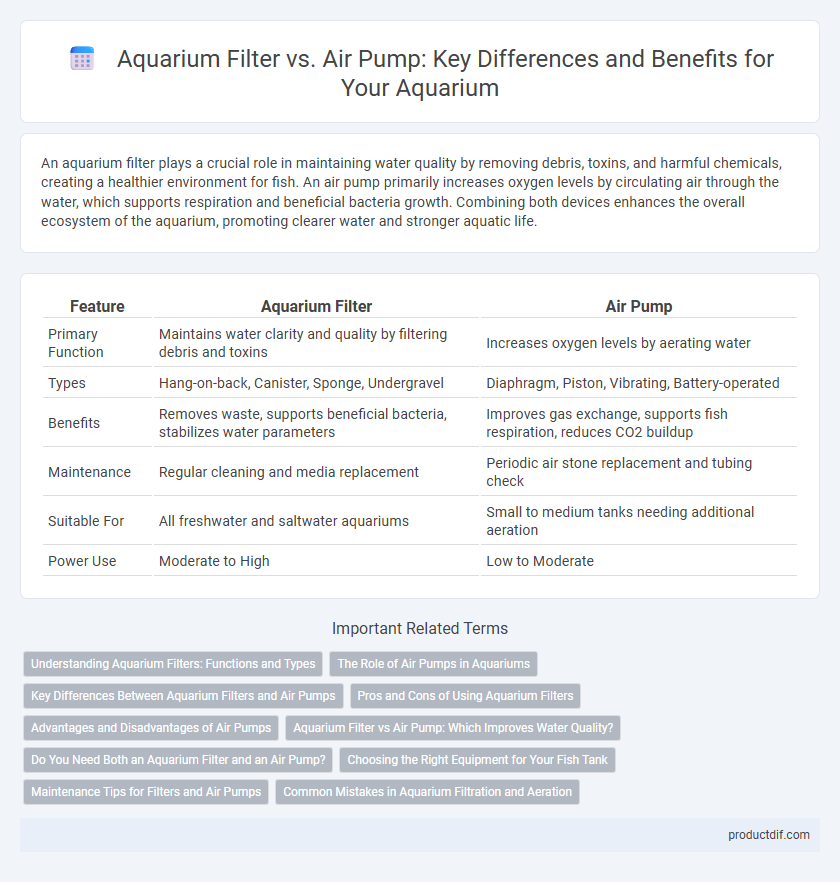An aquarium filter plays a crucial role in maintaining water quality by removing debris, toxins, and harmful chemicals, creating a healthier environment for fish. An air pump primarily increases oxygen levels by circulating air through the water, which supports respiration and beneficial bacteria growth. Combining both devices enhances the overall ecosystem of the aquarium, promoting clearer water and stronger aquatic life.
Table of Comparison
| Feature | Aquarium Filter | Air Pump |
|---|---|---|
| Primary Function | Maintains water clarity and quality by filtering debris and toxins | Increases oxygen levels by aerating water |
| Types | Hang-on-back, Canister, Sponge, Undergravel | Diaphragm, Piston, Vibrating, Battery-operated |
| Benefits | Removes waste, supports beneficial bacteria, stabilizes water parameters | Improves gas exchange, supports fish respiration, reduces CO2 buildup |
| Maintenance | Regular cleaning and media replacement | Periodic air stone replacement and tubing check |
| Suitable For | All freshwater and saltwater aquariums | Small to medium tanks needing additional aeration |
| Power Use | Moderate to High | Low to Moderate |
Understanding Aquarium Filters: Functions and Types
Aquarium filters play a crucial role in maintaining water quality by removing debris, harmful chemicals, and toxic substances to create a healthy environment for aquatic life. Common types include mechanical filters that trap particles, biological filters fostering beneficial bacteria to break down waste, and chemical filters using activated carbon to eliminate impurities. Understanding these functions helps aquarists select the appropriate filter, ensuring optimal oxygenation and clarity in the tank without solely relying on air pumps for aeration.
The Role of Air Pumps in Aquariums
Air pumps in aquariums play a crucial role in oxygenating water by creating surface agitation and promoting gas exchange, which supports healthy aquatic life. Unlike aquarium filters that primarily remove debris and harmful chemicals, air pumps enhance oxygen levels essential for fish respiration and beneficial bacteria activity. Proper aeration from air pumps also helps regulate water circulation and maintain a stable environment for aquatic plants and animals.
Key Differences Between Aquarium Filters and Air Pumps
Aquarium filters primarily focus on maintaining water quality by removing debris, toxins, and harmful bacteria, ensuring a healthy environment for aquatic life. Air pumps, on the other hand, primarily increase oxygen levels by circulating air through water, promoting gas exchange and improving fish respiration. While filters combine mechanical, biological, and chemical filtration, air pumps mainly serve to aerate the tank and support beneficial bacteria growth indirectly.
Pros and Cons of Using Aquarium Filters
Aquarium filters excel at maintaining water clarity and quality by mechanically, chemically, and biologically removing debris and harmful toxins, promoting a healthy aquatic environment. They require regular maintenance and can be noisy or consume more electricity compared to air pumps. While aquarium filters provide superior water purification, they are typically more expensive and complex to install than air pumps, which mainly oxygenate water without filtration benefits.
Advantages and Disadvantages of Air Pumps
Air pumps in aquariums enhance oxygen exchange by creating surface agitation and driving air through air stones, promoting healthier aquatic environments. They offer advantages such as low cost, ease of installation, and suitability for small to medium tanks, but can produce noise and vibrations that may disturb aquatic life. Unlike aquarium filters, air pumps do not remove debris or toxins, so they must be combined with filtration systems to maintain water quality effectively.
Aquarium Filter vs Air Pump: Which Improves Water Quality?
Aquarium filters and air pumps serve distinct roles in maintaining water quality, with filters primarily responsible for mechanical, chemical, and biological filtration to remove debris, toxins, and harmful bacteria from the water. Air pumps enhance oxygenation by increasing surface agitation, which helps support beneficial aerobic bacteria but do not directly purify water contaminants. For optimal aquarium health, combining a high-quality filtration system with an efficient air pump ensures cleaner water and better oxygen levels, promoting a balanced aquatic environment.
Do You Need Both an Aquarium Filter and an Air Pump?
An aquarium filter and an air pump serve distinct but complementary roles in maintaining a healthy aquatic environment; the filter removes waste and toxins, ensuring water clarity and quality, while the air pump increases oxygen circulation and surface agitation. Many aquarists find that using both devices together maximizes water oxygenation and cleanliness, especially in densely stocked or heavily planted tanks. Depending on tank size, fish species, and biological load, combining an efficient filter like a canister or hang-on-back model with a reliable air pump can significantly improve fish health and overall aquarium stability.
Choosing the Right Equipment for Your Fish Tank
Selecting the appropriate aquarium filter is essential for maintaining water clarity and removing toxins, ensuring a healthy environment for your fish. An air pump primarily enhances oxygen circulation and water movement, which supports aerobic bacteria but does not replace the mechanical and biological filtration provided by filters. Understanding the specific needs of your fish species and tank size will guide you in choosing between filtration systems or combining both for optimal water quality.
Maintenance Tips for Filters and Air Pumps
Regular cleaning of aquarium filters prevents clogging and maintains efficient water flow, essential for optimal filtration and fish health. Air pumps require periodic inspection of tubing and diaphragms to avoid air leaks and ensure consistent oxygenation in the tank. Replacing filter media and air pump components on schedule extends equipment lifespan and supports a stable aquatic environment.
Common Mistakes in Aquarium Filtration and Aeration
Using an air pump instead of an aquarium filter is a common mistake that leads to inadequate water filtration and poor waste removal, causing harmful toxin buildup in the tank. Many aquarium owners underestimate the importance of mechanical and biological filtration provided by quality filters, relying solely on aeration devices that only oxygenate the water without cleaning it. Selecting the appropriate equipment, such as canister or hang-on-back filters for efficient debris removal and beneficial bacteria support, ensures a healthy aquatic environment and optimal fish health.
Aquarium filter vs Air pump Infographic

 productdif.com
productdif.com